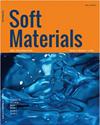A study of thickness dependent microstructure of poly (3-hexylthiophene) thin films using grazing incidence x-ray diffraction
IF 1.4
4区 材料科学
Q4 MATERIALS SCIENCE, MULTIDISCIPLINARY
引用次数: 4
Abstract
ABSTRACT Thin films of poly (3-hexylthiophene), abbreviated as P3HT, are widely used systems of semiconducting polymer for applications in organic electronic devices. We studied the microstructure of spin-coated thin films of P3HT using grazing incidence x-ray diffraction (GID) by combining high-resolution vertical scan with 2D intensity maps obtained using area detector. Microstructure of the films was quantitatively analyzed in terms of relative crystalline density, texture and coherence length. The structure of the films was relaxed by annealing at 110°C. The relaxed microstructure shows strong thickness dependence. Thick film (61 nm) was highly crystalline and textured. For thin film (32 nm), relative crystalline density was very weak but the coherence length of crystallites was larger and the orientation of crystallites was even more strongly textured. For thick film, the strong increase of crystalline density takes place through fresh nucleation and reorientation of crystallites already present in the films. For thin films, the substrate interaction induced very strong alignment of lamellar crystallites through degeneration of off-oriented crystallites and increased lamellar crystalline coherence. The drastic change of microstructure within a small thickness range is an important aspect to be considered while preparing thin film devices.用掠入射x射线衍射研究聚(3-己基噻吩)薄膜的厚度相关微观结构
摘要聚(3-己基噻吩)薄膜,简称P3HT,是一种广泛应用于有机电子器件的半导体聚合物体系。我们使用掠入射x射线衍射(GID),将高分辨率垂直扫描与使用区域检测器获得的2D强度图相结合,研究了P3HT旋涂薄膜的微观结构。从相对结晶密度、织构和相干性长度等方面对薄膜的微观结构进行了定量分析。薄膜的结构通过在110°C下退火而松弛。松弛的微观结构显示出强烈的厚度依赖性。厚膜(61nm)具有高度结晶性和纹理。对于薄膜(32nm),相对结晶密度非常弱,但晶粒的相干长度更大,并且晶粒的取向甚至更强烈地织构化。对于厚膜,晶体密度的强烈增加是通过薄膜中已经存在的晶粒的新成核和重新定向来实现的。对于薄膜,衬底相互作用通过偏离取向的晶粒的退化和增加的片层晶体相干性来诱导片层晶粒的非常强的排列。在制备薄膜器件时,微结构在小厚度范围内的剧烈变化是需要考虑的一个重要方面。
本文章由计算机程序翻译,如有差异,请以英文原文为准。
求助全文
约1分钟内获得全文
求助全文
来源期刊

Soft Materials
工程技术-材料科学:综合
CiteScore
2.90
自引率
0.00%
发文量
21
审稿时长
2.2 months
期刊介绍:
Providing a common forum for all soft matter scientists, Soft Materials covers theory, simulation, and experimental research in this rapidly expanding and interdisciplinary field. As soft materials are often at the heart of modern technologies, soft matter science has implications and applications in many areas ranging from biology to engineering.
Unlike many journals which focus primarily on individual classes of materials or particular applications, Soft Materials draw on all physical, chemical, materials science, and biological aspects of soft matter. Featured topics include polymers, biomacromolecules, colloids, membranes, Langmuir-Blodgett films, liquid crystals, granular matter, soft interfaces, complex fluids, surfactants, gels, nanomaterials, self-organization, supramolecular science, molecular recognition, soft glasses, amphiphiles, foams, and active matter.
Truly international in scope, Soft Materials contains original research, invited reviews, in-depth technical tutorials, and book reviews.
 求助内容:
求助内容: 应助结果提醒方式:
应助结果提醒方式:


